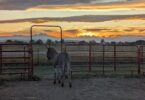Explaining horseshoes from the ground up.
Ever wondered why horseshoes are used? Curious why some horses go barefoot?
For thousands of years, people have used different methods to protect their horses’ feet. From woven hoof booties created by people in Asia to leather and metal ‘sandals’ crafted by the Romans, caring for horse hooves has been a priority for thousands of years.
Though nobody seems to know exactly when the first metal horseshoes with nails were invented, horseshoeing became a common practice in Europe around 1000 AD.
Today’s horseshoes are used for various reasons, such as correcting soundness issues, providing better traction, and supporting athletic efforts. For example, show jumpers often wear studs on their shoes for better traction, while reining horses often wear ‘sliders’ to encourage longer, smoother stops, and police horses wear shoes specifically designed for long days on the pavement.
Many disciplines utilize specific styles of shoeing to help horses perform their jobs better. Despite different styles, there are overarching themes when it comes to horseshoes and their uses.
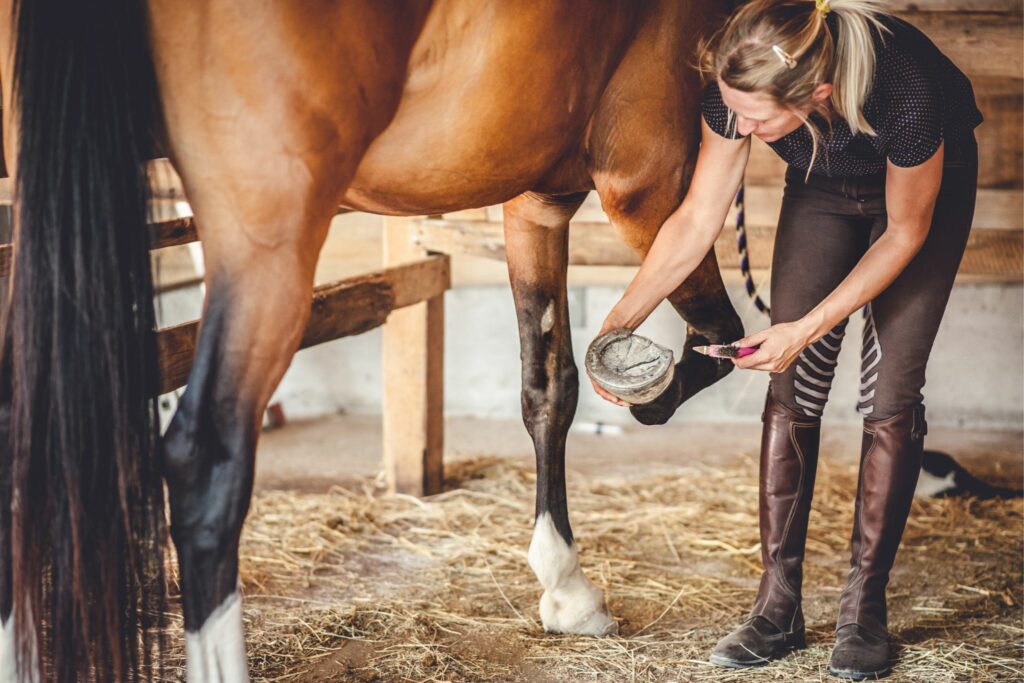
Source: Canva
All About Horseshoes
What is a Horseshoe?
A horseshoe is a piece of equipment, typically molded from metal, that helps protect equine hooves.
What are Common Types of Horseshoes?
There are many different types of horseshoes, each appropriate for specific needs.
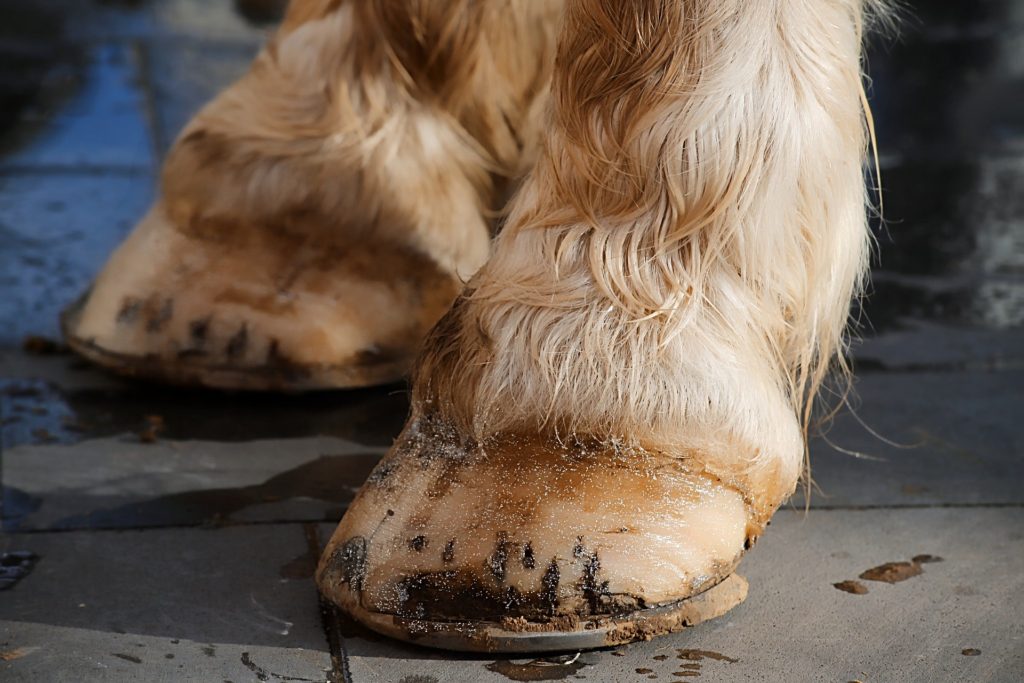
Source: Canva
The most common types of horseshoes include regular, rim, bar, egg bar, and heart bar.
- Regular: The most common form of a horseshoe and is used by the majority of riding horses.
- Rim: This style includes a deep groove in the middle of the shoe that provides more traction and is commonly used for barrel racing.
- Bar: It includes a bar at the heel that provides added support.
- Egg Bar: This style has a bar that extends beyond the heel and is often used for horses with navicular disease.
- Heart Bar: It includes a bar at the heel, as well as a piece for frog support, and is commonly used for horses with laminitis.
Why are Horseshoes Used?
Horses wear shoes to protect their feet. Horses that are used for riding or driving will wear shoes to help keep them sound and performing at their peak. Horses may also wear shoes to correct any lameness issues they may have.
How Often Do Horses Need Shoes?
Most horses need their hooves trimmed and re-shod every four to six weeks.
Hooves continuously grow (like human fingernails), so it’s important to keep your horse on a regular farrier schedule so their feet remain in top condition.
How Do You Shoe a Horse Step by Step?

Source: Canva
- The first step is to clean all dirt and debris from your horse’s hooves.
- Use a hoof knife to remove any excess sole from the bottom of the hoof.
- Use hoof nippers to trim the excess hoof wall to the appropriate length.
- Use a rasp to even out the hoof.
- Select the proper shoe size for your horse.
- Line the shoe up with the edge of the horse’s hoof.
- Hammer in the nails at an outward angle, so the nail tips go out through the hoof wall.
- Use the claw part of the hammer to bend and remove the nail tips.
- Use a clincher to pinch the nail ends into place.
- Use a rasp to smooth the outside of the hoof.
Do Horseshoes Hurt Horses?
When properly fitted and applied, horseshoes do not hurt horses.
Similar to how you can not feel your nails getting trimmed, a horse typically does not feel its hooves getting trimmed or shoes put on.
Read more about this in If the Shoe Fits: Why (Good) Horseshoes Don’t Hurt Horses.
What are the Best Horseshoe Alternatives?
If you don’t want to shoe your horse in the traditional way, it’s important to still protect their hooves from wear and tear.
One of the most popular alternatives is using hoof boots. They’re especially good for horses that are ridden long distances or on roads.
Hoof boots are durable and are often made from synthetic material.
Cavallo is the most respected producer, and there are several styles and sizes of hoof boots available on Amazon.
If hoof boots aren’t your cup of tea, you can check into glue-on shoes, hoof wraps, and rubber shoes. Or, chat with your farrier and vet about whether your horse may be able to go barefoot. Barefoot horses still require routine trimming, but don’t wear shoes.
Frequently Asked Questions
Q: How should you shoe a horse that kicks?
Horses that kick can pose a threat to people, other horses, and even themselves. Most commonly, stall kickers run the risk of getting leg or hoof injuries.
Since every horse is unique and there are several reasons they may kick, it is best to work with a combination of equine professionals to determine (and correct!) the root cause. Many farriers will refuse to work on horses that kick. Rule out any medical issues in advance and work with a trainer to correct any behavioral issues.
You can also talk to your vet to see if Dormosedan gel could help your specific situation. You’ll need a prescription from your vet to get it, but it can be easily administered in your horse’s mouth for a sedative effect.
Q: How should you shoe a horse that overreaches?
There are several reasons a horse may be overreaching. A horse may overreach because of how it is being ridden, its fitness level, or conformation.
If your horse is overreaching, have your farrier watch you ride so they can devise the best plan for corrective shoeing.
Q: How should you shoe a horse with a bowed tendon?
It can be beneficial to use a shoe with a rocker toe to help give the horse protection and allow them to heal.
Adding borium to the shoe can also provide traction to decrease strain on the leg.
Q: How should you shoe a horse with ringbone?
When a horse has ringbone, it is a continuous problem. It is important to keep the horse sound and to ease break-over to lessen the force placed on the lower joints.
Typically, these horses benefit from fitted square, rocker-toe, rolled, or half-rounded horseshoes.
Q: How should you shoe a horse with navicular disease?
A horse with navicular disease should always have shoes to help with the protection of the hoof and imbalances.
Adding a pad to the shoe may also decrease the effect the navicular bone has on the hoof while the horse is moving.
Q: Should a foundered horse have shoes?
Severe laminitis, or founder, can be debilitating, especially if the horse remains unshod.
A foundered horse needs specialized shoes that support the frog and distribute the horse’s weight evenly over the whole hoof. This is often done using a heart bar shoe with an adjustable frog plate.
Q: What horses don’t need shoes?
Many horses don’t need shoes. If your horse has healthy hooves and works mainly on arena footing or grass, they may not need shoes. It is best to discuss this with your farrier to find out if barefoot might be the best option for your horse.
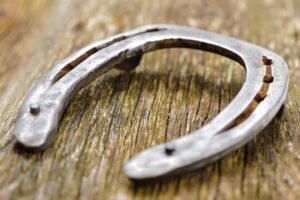
Source: Canva
Q: Why would you shoe only the front hooves?
Horses carry 60% of their weight on their front feet, so having shoes on their front hooves can be beneficial. The front hooves also tend to chip and crack more, so the hind hooves aren’t always in need of shoes.
Ask your farrier for advice.
Q: Do donkeys need shoes?
Most donkeys have sturdy hooves and do not need shoes. However, donkeys that are ridden often on rough terrain do benefit from wearing shoes.
Q: Do mules need shoes?
Mules tend to have stronger and more durable hooves than horses, so they often do not need shoes. Unless your mule is doing lots of work on rocky terrain or pavement, it will probably not need shoes.
Q: How are horseshoes made?
Most horseshoes are made from metal. To create a horseshoe, a bar of metal is cut and heated, then formed into a shape of a horseshoe. Then nail holes are added to the shoe.
When shoeing a horse, a farrier will then shape the shoe to the horse’s foot by heating and hammering the metal.
Q: What does it cost to shoe a horse?
Depending on the type of shoes and pads your horse gets, it typically costs between $90 – $150 per farrier visit.
Q: Are horseshoes cruel?
No. Properly-fitted horseshoes are not cruel and are often very beneficial for protecting horses from injury, sustaining peak athletic performance, adding traction, and correcting soundness issues.

Source: Canva
Q: Do horses need shoes for
It can be beneficial for horses that do trail riding to wear shoes. Wearing shoes provides protection, traction, and correction, all of which are beneficial for different terrains.
Q: Do racehorses wear shoes?
Almost all racehorses wear shoes, with the majority of them wearing aluminum plates. However, depending on the type of racetrack turf, there are certain restrictions regarding the type of shoe that can be worn.
Q: Why do wild horses not need shoes?
Wild horses are constantly on the move, traveling many miles per day. Often wild horses travel over rough terrain for long distances, which naturally wears down their hooves. Wild horses have evolved to have tough hooves based on their environment–domesticated horses haven’t had the benefit of natural selection when it comes to hoof quality.
Q: What happens if you don’t put shoes on a horse?
In most cases, nothing. Many horses can live their lives completely free of shoes. Some horses, however, might be lame without shoes. Others need extra support because of their workload.
Many people will cite wild horses and their bare feet in their argument against shoes. However, wild horses don’t work in the same way domesticated horses do.
It’s best to listen to the recommendation of your farrier. Whether your horse has low heels, is prone to hoof cracks, or needs protection to prevent his hooves from wearing down too quickly, shoes can be a simple way to help your horse live his best life.
Q: Do horses feel pain in their hooves?
The hoof wall is very similar to human nails. Trimming and shoeing don’t cause pain because there are no nerve endings in that part of the hoof.
Horses do have some feeling in that area, however, They can feel the file going across and the pounding of the nail going in. This feeling also helps them stay steady on their feet (imagine trying to walk around on completely numb feet).
Other parts of the hoof, like the sole or the interior, can feel pain. This is why bruises and abscesses are so painful.
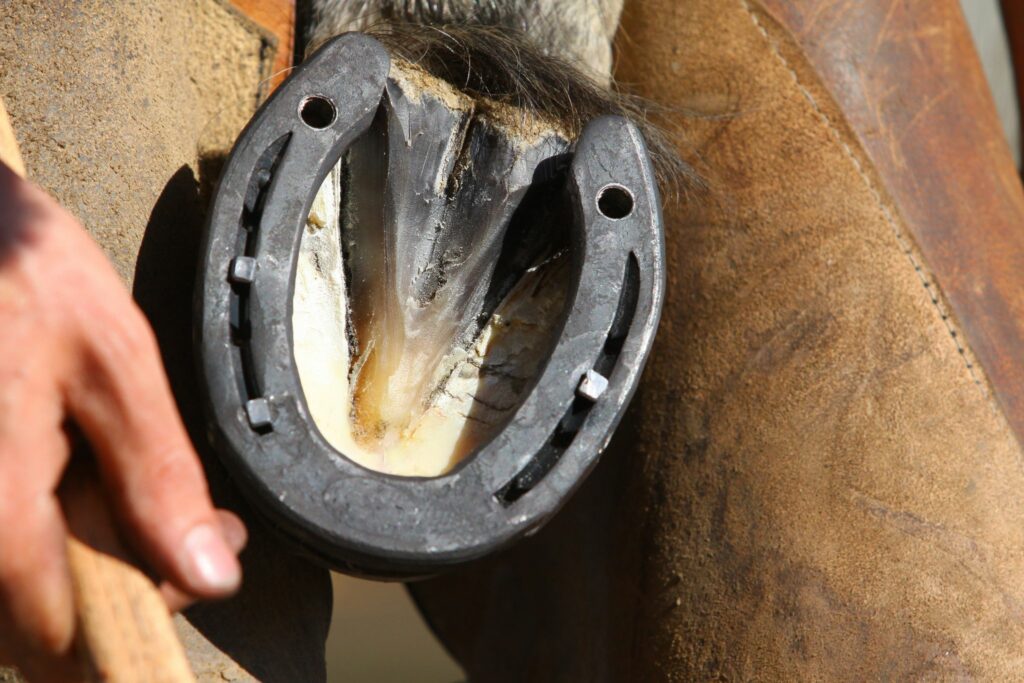
Source: Canva
Goody Four Shoes
Shoeing your horse can be beneficial for its health and performance. There are many different shoeing options available, and your chosen discipline(s) will influence the type of support your horse requires.
Always talk to your farrier before making decisions about your shoeing strategy.
P.S. Enjoy this article? Trot on over to:
- If the Shoe Fits: Why (Good) Horseshoes Don’t Hurt Horses
- Horse Hoof Terminology Every Equestrian Should Know
- Horse Lifespan 101 (Life Stages, Teeth, Senior Horse Care)
- Ringbone Reality Check: What It Could Mean for Your Horse
- The Real Cost of Horse Ownership: Monthly Horse Expense Reports
- Equine Shelter 101: Do all horses need a stable?
- Beginner’s Guide to Equine Insurance (And Peace of Mind)
- Fact or Fiction: Do Horses Eat Meat? (You’ll Be Surprised!)
- The Mighty Mule: Strong, Surefooted and SO Clever
- Foundering in Horses: Figure Out Your Fix
Sources
- https://www.americanfarriers.com/articles/7867-pricing-for-success?v=preview
- https://paintedqhfarm.weebly.com/mule-facts.html
- https://www.chronofhorse.com/forum/forum/discussion-forums/horse-care/49451-explain-the-reason-for-no-back-shoes
- https://practicalhorsemanmag.com/health-archive/coping-with-navicular-disease
- https://thehorse.com/132617/shoeing-prescription-for-ringbone/
- https://www.americanfarriers.com/articles/8111-hoof-beats-dont-bow-to-the-bow
- https://americanequus.com/history-of-horeshoes/#:~:text=The%20earliest%20forms%20of%20horseshoes,made%20out%20of%20woven%20plants.
- https://www.thefarrierguide.com/2014/shoeing-different-disciplines/
- https://www.hghorseshoeing.com/common-types-of-horseshoes/
- https://kb.rspca.org.au/how-often-should-my-horse-see-the-farrier_485.html
- https://www.wikihow.com/Shoe-a-Horse
- https://www.horseillustrated.com/horse-health-alternative-hoofwear
- https://www.espn.com/horse-racing/triplecrown08/news/story?id=3377688
- https://www.madehow.com/Volume-6/Horseshoe.html








